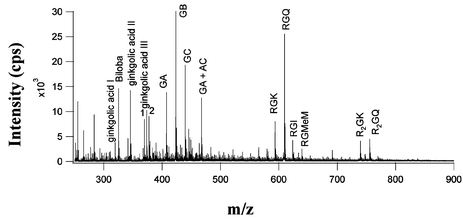Detection of fortification of ginkgo products using nanoelectrospray ionization mass spectrometry†
Abstract
We report here a negative ionization nanoelectrospray ionization mass spectrometry (nanoESI-MS) technique that simultaneously detects active components, terpenes and intact flavonol glycosides, and toxic ginkgolic acids in ginkgo products. Unlike the conventional methods that hydrolyze flavonol glycosides to flavonoids for analysis, this technique directly detects intact flavonol glycosides, enabling differentiation of these natural glycosides from the synthetic flavonoids. Thus, it allows the detection of fortification of ginkgo products, alleviating a common problem encountered by the conventional methods. Analysis of 14 commercial ginkgo products using this technique demonstrates large variations and deviation from the well-accepted standardized ginkgo extract. Four products showed evidence of fortification with synthetic surrogates. Two products were found to have toxic ginkgolic acids that exceed the 5 µg g−1 limit by as much as 60000 fold. These results emphasize the importance of appropriate monitoring of ginkgo product quality.


 Please wait while we load your content...
Please wait while we load your content...